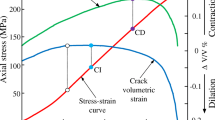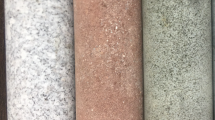Abstract
When rock samples are loaded until macroscopic fractures develop, the failure process can be divided into several stages based on axial and lateral strain responses or the acoustic emission sequence during uniaxial compression tests. Several stress thresholds may be identified: the crack closure stress σ cc, crack initiation stress σ ci, crack damage stress σ cd, and uniaxial compressive strength σ ucs; these may be used as a warning indicator for rock rupture. We investigated the crack damage stress σ cd, its threshold, and a possible relationship between σ cd and the uniaxial compressive strength. The σ cd of different rock types were compiled from previous studies based on uniaxial compression tests. The results showed that the overall averages and standard deviations of σ cd /σ ucs for igneous, metamorphic, and sedimentary rocks were ~0.78 (±0.11), ~0.85 (±0.11), and ~0.73 (±0.18), respectively. There were no significant differences in σ cd /σ ucs between the different rock types, except that the sedimentary rock had a slightly larger standard deviation attributed to the variation of porosity in the samples, while the metamorphic rock had higher average σ cd /σ ucs resulting from the small statistical sample size. By excluding the higher-porosity (>10 %) rock samples, the averages and standard deviations of σ cd /σ ucs for igneous, metamorphic, and sedimentary rocks were ~0.78 (±0.09), ~0.85 (±0.09), and ~0.78 (±0.11), respectively. The results imply that the rock origin process (i.e., igneous, metamorphic, and sedimentary) has a minimal effect on σ cd /σ ucs. The ratio σ cd/σ ucs could be an essential intrinsic property for low-porosity rocks, which could be used in rock engineering for predicting the failure process.










Similar content being viewed by others
References
Amann F, Button ED, Evans KF, Gischig VS, Blümel M (2011) Experimental study of the brittle behavior of clay shale in rapid unconfined compression. Rock Mech Rock Eng 44(4):415–430
Andersson JF, Martin CD, Stille H (2009) The Äspö pillar stability experiment: part II—rock mass response to coupled excavation-induced and thermal-induced stresses. Int J Rock Mech Min Sci 46(5):879–895
Bäckblom G, Martin CD (1999) Recent experiments in hard rocks to study the excavation response: implications for the performance of a nuclear waste geological repository. Tunn Undergr Space Technol 14(3):377–394
Benson SM, Cook P (2005) Underground geological storage. In: Metz B, Davidson O, de Coninck H, Loss M, Meyer L (eds) IPCC Special report on carbon dioxide capture and storage, intergovernmental panel on climate change. Cambridge University Press, London, pp 195–276
Bieniawski ZT (1967a) Mechanism of brittle rock fracture. Part I. Theory of the fracture process. Int J Rock Mech Min Sci 4(4):395–406
Bieniawski ZT (1967b) Mechanism of brittle rock fracture. Part II. Experimental studies. Int J Rock Mech Min Sci 4(4):407–423
Brace WF, Paulding BW, Scholz C (1966) Dilatancy in the fracture of crystalline rocks. J Geophys Res 71(16):3939–3953
Cai M, Kaiser PK, Tasaka Y, Morioka H, Minami M (2004) Generalized crack initiation and crack damage stress thresholds of brittle rock masses near underground excavations. Int J Rock Mech Min Sci 41(5):833–847
Chang SH, Lee CI (2004) Estimation of cracking and damage mechanisms in rock under triaxial compression by moment tensor analysis of acoustic emission. Int J Rock Mech Min Sci 41(7):1069–1086
Chen GE, Lin YM (2004) Stress–strain-electrical resistance effects and associated state equations for uniaxial rock compression. Int J Rock Mech Min Sci 41(2):223–236
Chen YF, Li DQ, Jiang QH, Zhou CB (2012) Micromechanical analysis of anisotropic damage and its influence on effective thermal conductivity in brittle rocks. Int J Rock Mech Min Sci 50:102–116
Cristescu ND (1985) Viscoplastic creep of rocks around horizontal tunnels. Int J Rock Mech Min Sci 22(6):453–459
Cristescu ND (2002) New trends in rock mechanics. Int Appl Mech 38(1):1–22
Diederichs MS, Kaiser PK, Eberhardt E (2004) Damage initiation and propagation in hard rock during tunnelling and the influence of near-face stress rotation. Int J Rock Mech Min Sci 41(5):785–812
Ding WL, Li C, Li CY, Xu CC, Jiu K, Zeng WT, Wu LM (2012) Fracture development in shale and its relationship to gas accumulation. Geosci Front 3(1):97–105
Eberhardt E (1998) Brittle rock fracture and progressive damage in uniaxial compression. Ph.D Thesis, Department of Geological Sciences, University of Saskatchewan, Saskatoon
Eberhardt E, Stead D, Stimpson B, Read RS (1997) Changes in acoustic event properties with progressive fracture damage. Int J Rock Mech Min Sci 34(3–4):71.e1–71.e12
Eberhardt E, Stead D, Stimpson B, Read RS (1998) Identifying crack initiation and propagation thresholds in brittle rock. Can Geotech J 35(2):222–233
Eberhardt E, Stead D, Stimpson B (1999) Quantifying progressive pre-peak brittle fracture damage in rock during uniaxial compression. Int J Rock Mech Min Sci 36(3):361–380
Eslami J, Hoxha D, Grgic D (2012) Estimation of the damage of a porous limestone using continuous wave velocity measurements during uniaxial creep tests. Mech Mater 49:51–65
Gatelier N, Pellet F, Loret B (2002) Mechanical damage of an anisotropic porous rock in cyclic triaxial tests. Int J Rock Mech Min Sci 39(3):335–354
Hatzor YH, Zur A, Mimran Y (1997) Microstructure effects on microcracking and brittle failure of dolomites. Tectonophysics 281(3–4):141–161
He MC, Wang CG, Feng JL, Li DJ, Zhang GY (2010) Experimental investigations on gas desorption and transport in stressed coal under isothermal conditions. Int J Coal Geol 83(4):377–386
Heap MJ, Vinciguerra S, Meredith PG (2009) The evolution of elastic moduli with increasing crack damage during cyclic stressing of a basalt from Mt. Etna volcano. Tectonophysics 471(1–2):153–160
Hidalgo KP, Nordlund E (2012) Failure process analysis of spalling failure-Comparison of laboratory test and numerical modelling data. Tunn Undergr Space Technol 32:66–77
Hidalgo KP, Nordlund E (2013) Comparison between stress and strain quantities of the failure–deformation process of fennoscandian hard rocks using geological information. Rock Mech Rock Eng 46(1):41–51
Hu DW, Zhou H, Zhang F, Shao JF (2010) Evolution of poroelastic properties and permeability in damaged sandstone. Int J Rock Mech Min Sci 47(6):962–973
Huang D, Huang RQ, Zhang YX (2012) Experimental investigations on static loading rate effects on mechanical properties and energy mechanism of coarse crystal grain marble under uniaxial compression. Chin Journal Rock Mech Eng 31(2):245–255 (in Chinese)
Jiang YD, Xian XF, Xiong DG, Zhou FC (2005) Study on creep behaviour of sandstone and its mechanical models. Chin J Geotech Eng 27(12):1478–1481 (in Chinese)
Jiang T, Shao JF, Xu WY, Zhou CB (2010) Experimental investigation and micromechanical analysis of damage and permeability variation in brittle rocks. Int J Rock Mech Min Sci 47(5):703–713
Klein E, Reuschlé T (2004) A pore crack model for the mechanical behaviour of porous granular rocks in the brittle deformation regime. Int J Rock Mech Min Sci 41(6):975–986
Lajtai EZ, Lajtai VN (1974) The evolution of brittle fracture in rocks. J Geol Soc Lond 130(1):1–18
Li S, Lajtai EZ (1998) Modeling the stress–strain diagram for brittle rock loaded in compression. Mech Mater 30(3):243–251
Li HB, Zhao J, Li TJ (2000) Micromechanical modelling of the mechanical properties of a granite under dynamic uniaxial compressive loads. Int J Rock Mech Min Sci 37(6):923–935
Liang WG, Zhao YS, Xu SG, Dusseault MB (2011) Effect of strain rate on the mechanical properties of salt rock. Int J Rock Mech Min Sci 48(1):161–167
Liang CY, Li X, Wang SX, Li SD, He JM, Ma CF (2012) Experimental investigations on rate-dependent stress-strain characteristics and energy mechanism of rock under uniaxial compression. Chin J Rock Mech Eng 31(9):1830–1838 (in Chinese)
Lin QX, Liu YM, Tham LG, Tang CA, Lee PKK, Wang J (2009) Time-dependent strength degradation of granite. Int J Rock Mech Min Sci 46(7):1103–1114
Martin CD (1993) Strength of Massive Lac du Bonnet Granite around Underground Openings. Ph.D Thesis, Department of Civil and Geological Engineering, University of Manitoba, Winnipeg
Martin CD, Chandler NA (1994) The progressive fracture of Lac du Bonnet granite. Int J Rock Mech Min Sci 31(6):643–659
Martin CD, Christiansson R (2009) Estimating the potential for spalling around a deep nuclear waste repository in crystalline rock. Int J Rock Mech Min Sci 46(2):219–228
Nicksiar M, Martin CD (2012) Evaluation of methods for determining crack initiation in compression tests on low-porosity rocks. Rock Mech Rock Eng 45(4):607–617
Palchik V, Hatzor YH (2002) Crack damage stress as a composite function of porosity and elastic matrix stiffness in dolomites and limestones. Eng Geol 63(3–4):233–245
Paterson MS (1978) Experimental rock deformation—the brittle field. Springer, Berlin
Pellet FL, Keshavarz M, Hosseini KA (2011) Mechanical damage of a crystalline rock having experienced ultra high deviatoric stress up to 1.7 GPa. Int J Rock Mech Min Sci 48(8):1364–1368
Ranjith PG, Jasinge D, Choi SK, Mehic M, Shannon B (2010) The effect of CO2 saturation on mechanical properties of Australian black coal using acoustic emission. Fuel 89(8):2110–2117
Schöpfer MPJ, Abe S, Childs C, Walsh JJ (2009) The impact of porosity and crack density on the elasticity, strength and friction of cohesive granular materials: insights from DEM modelling. Int J Rock Mech Min Sci 46(2):250–261
Schulze Q, Popp T, Kern H (2001) Development of damage and permeability in deforming rock salt. Eng Geol 61(2–3):163–180
Souley M, Homand F, Pepa S, Hoxha D (2001) Damage-induced permeability changes in granite: a case example at the URL in Canada. Int J Rock Mech Min Sci 38(2):297–310
Takarli M, Prince W, Siddique R (2008) Damage in granite under heating/cooling cycles and water freeze-thaw condition. Int J Rock Mech Min Sci 45(7):1164–1175
Wu FQ, Liu JY, Liu T, Zhuang HZ, Yan CG (2009) A method for assessment of excavation damaged zone (EDZ) of a rock mass and its application to a dam foundation case. Eng Geol 104(1):254–262
Xie SY, Shao JF, Xu WY (2011) Influences of chemical degradation on mechanical behaviour of a limestone. Int J Rock Mech Min Sci 48(5):741–747
Xu NC, Yang XY, Qin J (2012) Relationship between rock’s bulk strain and long-term strength under uniaxial compression. J Liaoning Tech Univ 31(3):358–361 (in Chinese)
Acknowledgments
This work was supported by the Science Foundation of Key Laboratory of Engineering Geomechanics, Institute of Geology and Geophysics, Chinese Academy of Sciences (No. KLEG201106), the China Postdoctoral Science Foundation funded project (No. 2012M520376), the National Program on Key Basic Research Project (Program 973, No. 2013CB036404), and the National Natural Science Foundation of China (No. 41030750, 41302233 and 41102201). The authors would also like to express special thanks to the editor and anonymous reviewers for their suggestions.
Author information
Authors and Affiliations
Corresponding author
Rights and permissions
About this article
Cite this article
Xue, L., Qin, S., Sun, Q. et al. A Study on Crack Damage Stress Thresholds of Different Rock Types Based on Uniaxial Compression Tests. Rock Mech Rock Eng 47, 1183–1195 (2014). https://doi.org/10.1007/s00603-013-0479-3
Received:
Accepted:
Published:
Issue Date:
DOI: https://doi.org/10.1007/s00603-013-0479-3




